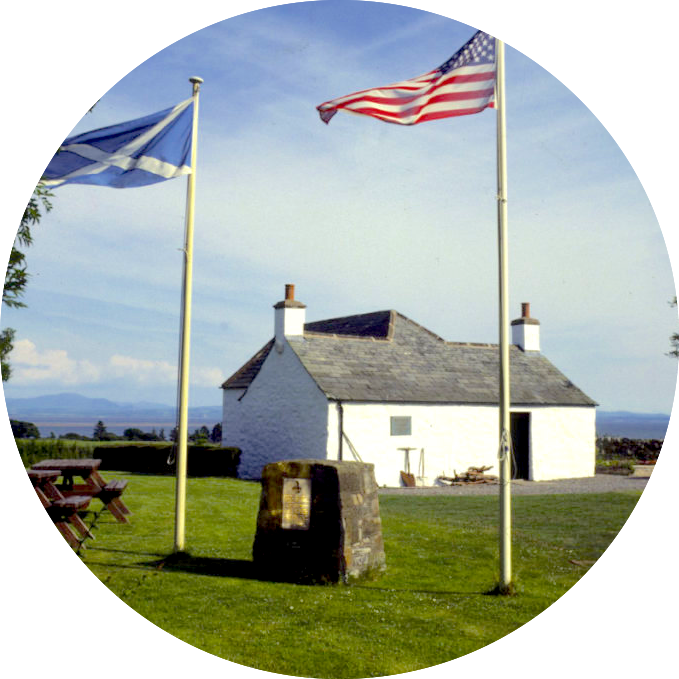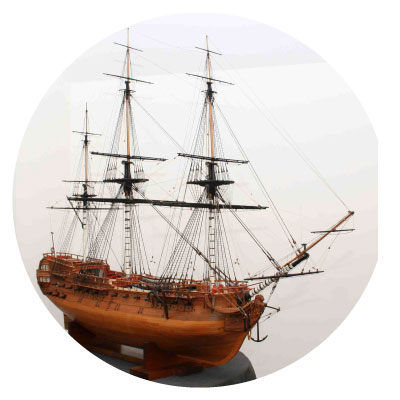History of John Paul Jones Cottage

John Paul Jones Cottage 1905
It is now over 60 years since the late Admiral Jerauld Wright USN had the idea of forming a museum in the cottage where the US Naval hero was born. In 1953 a bronze plaque – the gift of the Naval Historical Foundation and the Army/Navy Chapters of the Daughters of the American Revolution – was unveiled by the Honourable Winthrop Aldrich then US Ambassador in London in the presence of the Minister of State for Scotland – the Rt Hon The Earl of Home – and of course Admiral Wright who had organised the event.
On his retirement Admiral Wright continued his efforts to raise money to restore the cottage to the conditions of 1747. He was fortunate in having a great friend in the area – a retired Admiral of the Royal Navy, the late Admiral Sir Nigel Henderson – who brought his influence on the local authorities and in 1990 the plan was put into motion. In 1993 the museum was officially opened by Vice Admiral Edward Clexton Jnr USN who was serving in Britain at the time.
Curiously it is not the first time that the American Navy has come to the rescue of Jones’ home. In 1831 a Lieutenant Pinckham USN visited Scotland with the specific intention of seeking out the great man’s birthplace. The editor of the local paper takes up the story. When Mr. Pinckham visited Arbigland, the cottage in which his adopted countryman was born, it was roofless and ruin – a spectacle which affected him even to tears. Having made a drawing of it, he withdrew slowly, and not without casting a wistful look behind, until at length some undefinable feeling shaped itself into a determination to repair, if permitted, at his own expense, a ruin so interesting. Accordingly he deposited with the writer twenty-five sovereigns to be employed in the repairing the cot in which Paul Jones was born, so as to render it habitable.
The site of the cottage is a glade in a thriving wood on the shores of the Solway, with a green in front, fancifully railed in, and tastefully ornamented with evergreens, flowers, and flowering shrubs. Inside and out it is a trim cottage which may well vie with similar buildings in England, and as the walls are whitened annually with the finest lime, it has become a sort of landmark to nearly every sail that enters the Solway. The widow of a fisherman who died under highly distressing circumstances, and who owes much to the humanity of Mr Craik, the landowner, tenants it rent-free, and will probably close her eyes under its honoured roof; and as this fact is generally known, almost every tar in passing the spot, doffs his bonnet in a token of gratitude, and says “God bless the kind Lieutenant Pinckham.
The Cottage Today

The two-roomed Cottage, furnished in the style of the 1700s, is a fitting memorial to the swashbuckling hero.
The extension adjoining the cottage was built to provide an extra bedroom and was probably constructed with the 25 Sovereigns left by Lt. Pinckham, with the Laird of Arbigland estate to whom the cottage belonged. The Laird did use the money to repair the cottage and also built the subsequent two additions to make it more habitable in the 1800s.
In a nearby building, there is an exhibition gallery with an inviting museum shop. There is also an attractive rural picnic area offering marvelous views of the Solway and the Lake District. The Cottage and museum have a admission charge of £4.50 per adult, £4 concessions and children are free!
All of this is contained in a small area of land which the Trust owns within the grounds of Arbigland Estate.
There is also a fantastic collection of Playmobil Pirate ships in the Museum for children to play with. New for this year a free Treasure Hunt for children with gold at the end of it!
The premises are open every day from 1st April to 30th September.
 Bonhomme Richard
Bonhomme Richard
One of the nicest items we have on display is a specially commissioned scale model of the Bonhomme Richard sponsored by the family of the late Admiral Sir Nigel Henderson and Dumfries and Galloway European Partnership.Built originally in 1765 as the East Indiaman the Duc de Duras, extensive modifications were carried out to John Paul Jones specifications at the Royal Dockyard at L’Orient in 1779. These included piercing the hull for additional guns, reinforcing the gundeck timbers to carry the 28 18-pounders, lengthening the poopdeck to provide additional officers’accommodation and various other alterations the vessel being renamed the Bonhomme Richard.
The model is built to a scale of 3/16″ = 1ft and is constructed throughout of boxwood and ebony and is fully rigged with all the standing and running rigging.
At 10.30am on Saturday, September 25th 1779 after the epic sea battle with H.M.S. Serapis off Flamborough Head Paul Jones sadly watched from the Serapis’ quarterdeck as Bonhomme Richard sank slowly beneath the windswept sea, her colours still flying from her mainmast.
Model by: Martin R. Harrop (1940-2011), Model Shipwright
Further information on the ‘Bonnhomme Richard’ can be found here.
